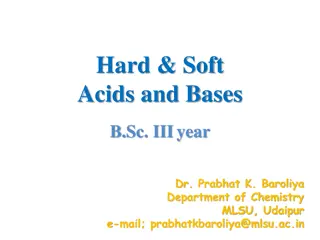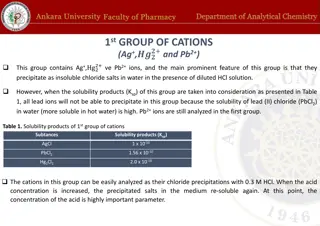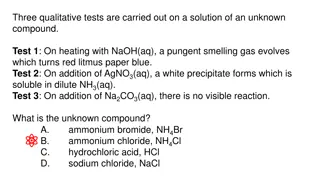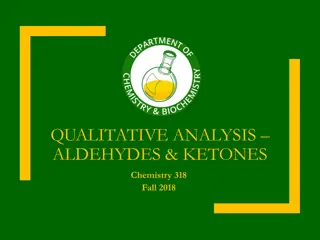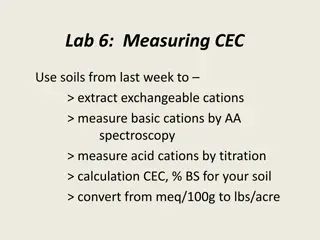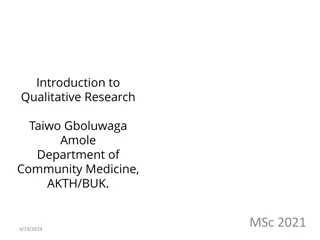Qualitative Analysis of Cations in Chemistry Experiments
Explore the qualitative analysis of cations such as calcium, aluminum, zinc, and lead through various tests with reagents like sodium hydroxide and ammonia. Learn how to observe and distinguish different cations based on their distinct reactions and characteristics in solution. The tests provide insights into the presence of specific cations by observing the formation of white precipitates and their solubility behavior, aiding in the identification of metal ions in solution.
Download Presentation

Please find below an Image/Link to download the presentation.
The content on the website is provided AS IS for your information and personal use only. It may not be sold, licensed, or shared on other websites without obtaining consent from the author. Download presentation by click this link. If you encounter any issues during the download, it is possible that the publisher has removed the file from their server.
E N D
Presentation Transcript
TESTING FOR CATIONS QUALITATIVE ANALYSIS
Calcium (Ca2+) Test with aqueous sodium hydroxide White ppt. insoluble in excess Test with aqueous ammonia No ppt. or very slight white ppt.
Calcium ions: Ca2+(aq) + 2OH-(aq) Ca(OH)2(s) white ppt. The ppt. is not soluble in excess of NH3 or NaOH. The test for Mg2+ and Ca2+ have similar tests and similar results. You could distinguish Mg from Ca with a flame test
TEST FOR CATIONS CA2+ / PB2+ / ZN2+ Observation: White ppt., soluble in excess, giving a colourless solution. Conclusion: Pb2+ / Zn2+ is present. Observation: White White ppt., insoluble in excess. Conclusion: Ca2+ is present. Observation: White White ppt. observed.
Aluminium(Al3+) Ions Test with aqueous sodium hydroxide Solution White ppt. White ppt. soluble soluble in in excess excess giving a giving a colourless colourless solution solution Test with aqueous ammonia Solution White ppt. White ppt. insoluble insoluble in in excess excess Al3+ +3OH- Al(OH)3(s) in excess NaOH forms soluble (Al(OH)4-
Zinc (Zn2+) Ions Test with aqueous sodium hydroxide Solution White ppt. White ppt. soluble soluble in in excess excess giving a giving a colourless colourless solution solution Test with aqueous ammonia Solution White ppt. White ppt. Soluble Soluble in in excess excess -Zn2+(aq) + 2OH-(aq) Zn(OH)2(s) white ppt. The ppt. dissolves in both excess sodium hydroxide and ammonia to give a clear colourless solution.
Lead (Pb2+) Ions Test with aqueous sodium hydroxide Solution White ppt. White ppt. soluble soluble in in excess excess giving a giving a colourless colourless solution solution Test with aqueous ammonia Solution White ppt. White ppt. Soluble Soluble in in excess excess -
3+ I In n Aqueous Aqueous Ammonia Ammonia and and NaOH NaOH: : Fe Fe2+ Aqueous ammonia and NaOH reacts with Fe(II) ions to produce green ppt Fe(OH)2, which oxidizes to form red-brown Fe(OH)3: 2+ and and Fe Fe3+ Insoluble in excess Insoluble in excess Both Solutions React with Fe(III) ions to produce red-brown Fe(OH)3: Insoluble in excess Insoluble in excess
Copper (Cu2+) Test with aqueous sodium hydroxide Solution Light blue ppt. insoluble in excess
Copper (Cu2+) Test with aqueous ammonia Solution Light blue ppt. soluble in excess giving a deep-blue solution
TEST FOR CATIONS Conclusion Observations
Halide tests Halide tests ( (Cl The Acidified silver nitrate Test. The test will give a white precipitate of silver chloride, a cream (off white) precipitate of silver bromide and a yellow precipitate of silver iodide. Cl- -, Br , Br- - ,I ,I- -) )
SULPHATE IONS SULPHATE IONS. . The barium chloride test for sulphate (SO The barium chloride test for sulphate (SO4 42 2- -) ) ions. ions. Any soluble sulphate will give a white precipitate of barium sulphate. The test is made in the presence of dilute hydrochloric acid to remove any carbonate or sulphite ions which may be present. These ions will also produce a precipitate which would confuse the results.
CARBONATE IONS. CARBONATE IONS. ACID TEST ACID TEST Any carbonate will produce carbon dioxide gas when you add a dilute acid. The carbon dioxide gas is identified using lime water, which goes milky
TEST FOR ANIONS Observations Conclusion
TEST FOR GASES SULFUR DIOXIDE (SO2) Observations : Effervescence observed. Gas evolved turns aqueous acidified potassium dichromate (VI) from orange to green. Conclusion : Sulfur dioxide gas is evolved.
COMMON METALS iron filings zinc powder magnesium ribbon copper turnings lead aluminium foil








